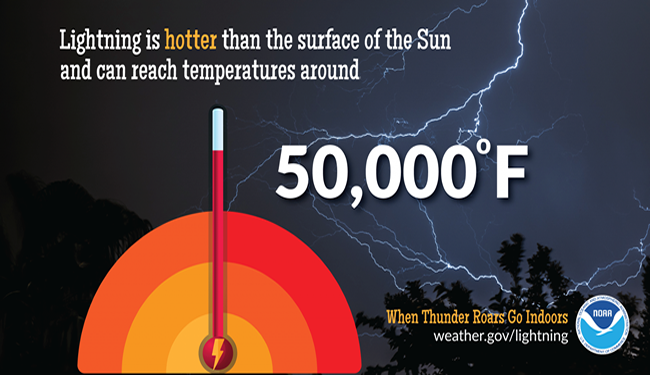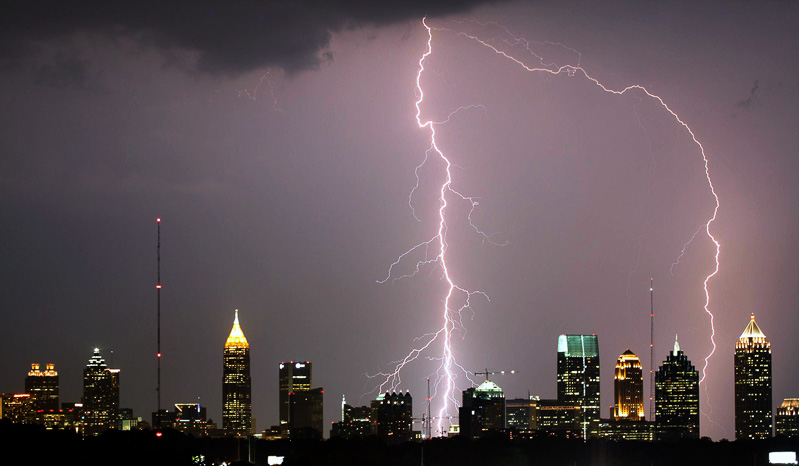We’ve spent significant time inside over the past five months. Telework, virtual meetings, gym closures, and the cancellation of many typical spring and summer activities have us antsy! Fresh air, the great outdoors, and recreation alleviates stress. As we enter the heart of summer, most of us cannot imagine life without outdoor barbecues, beach days, and pool parties. However, while warmer weather motivates us to spend more time outdoors, it also gives rise to ideal atmospheric conditions that generate thunderstorms and lightning. So, even though the 2020 hurricane season remains in the forefront, the Disaster Preparedness Program also encourages you to remain cognizant of additional seasonal hazards, such as lightning.
A typical lightning strike may be anywhere from 20 million to 1 billion volts with an approximate temperature of 8,000°C. Lightning deaths and injuries from direct lightning strikes are rare, and injuries are most commonly the result of the current radiating out from the ground strike. Strikes can occur faster than the blink of an eye, and just as quickly, so too can lives be altered forever.

In the Blink of an Eye
My perspective was forever altered by lightning in 2015. I had just concluded three beautiful years with the U.S. Coast Guard’s International Training Branch. This unit deploys small teams worldwide to provide technical training and consulting services for countries with waterway law enforcement programs. A frequent practice was to pass down lessons learned, safety considerations, and location highlights to successive teams.
One such team traveling to Costa Rica to support a joint agency exercise followed up on a recommendation I had made to visit the Poás Volcano National Park. The volcano stands 8,659 feet above sea level and the Poás crater, at almost a mile in diameter, is one of the largest active craters in the world. The crater’s viewing platform provides an incredible aspect of smoke and steam rising from fumaroles deep inside. But, at 12:30 p.m. on Sept. 17, 2015, a sudden thunderstorm passed through the area, and before park rangers could clear the volcano’s scenic overlook, lightning struck the ground roughly 25 meters away from three active duty U.S. Coast Guard members, knocking them to the ground.
One of the individuals, shaken but conscious, was able to gather his bearings and quickly provided CPR to the two other unconscious individuals. To this day, I am thankful for his quick thinking, rapid call to action, and for the assistance from park rangers, which resulted in their survival. All three were treated for first- and second-degree burns to their chest, stomach, and legs. Two were also treated for open head lacerations, which occurred as a result of collapsing after the strike. Impacts from the event will surely stay with all of them forever.
If you take nothing else away from this blog, please remember this: if you are ever in a position where someone near you has been struck by lightning, they DO NOT carry an electrical charge, and they may need medical attention immediately. The cause of most lightning fatalities is cardiac arrest. If a strike occurs, call for help, call 911, and begin administering first aid if warranted, and if you are certified and able.
Lighting Safety and Awareness
Cloud to ground lightning strikes the U.S. about 25 million times a year and consistently ranks as one of the top three causes of storm-related deaths. Even though the National Weather Service estimates that a person living in the U.S. has only a 1 to 10,000 risk of being struck by lightning by the time he or she reaches 80 years of age, regional, seasonal, and occupational factors can put you at higher risk. For instance, most lightning strikes occur in the summer months, especially July, during the afternoon and evening.
While lightning affects all regions of the U.S., the Southeastern states pose a higher risk, with Texas and Florida having the most significant number of lightning-related deaths. Lightning generally decreases from the southeast to the northwest, except for a few places such as the Rocky Mountains, where topography causes regular thunderstorms during the summer. Lightning most often strikes people who work outside or engage in outdoor recreational activities. So while the chances of being struck by lightning are low, the ramifications should motivate us all to respect and understand lightning safety fundamentals.

Lightning Safety Outdoors
There is no safe place outside when a summer thunderstorm moves in quickly. The phrase “When thunder roars, go indoors” is a popular mnemonic. Here are some safety tips to follow if you’re outdoors when lightning strikes:
- Check NOAA Weather Reports before planning outdoor activities to avoid being caught outside in hazardous weather conditions. Watch for darkening clouds and increasing wind speeds, which can indicate developing thunderstorms.
- Follow the National Weather Service lighting safety slogan, "When thunder roars, go indoors." Find a safe, enclosed shelter indoors or inside your vehicle with the windows rolled up.
- Do NOT lie down. Lightning causes electric currents along the top of the ground that can be deadly over 100 feet away.
- Separate: if you are in a group during a thunderstorm, separate from each other. This small action can reduce the number of injuries if lightning strikes the ground.
- DO NOT stay in open vehicles, structures, and spaces. During a thunderstorm, avoid open vehicles such as convertibles, motorcycles, and golf carts. Be sure to avoid open structures such as porches, gazebos, baseball dugouts, and sports arenas. And stay away from open spaces such as golf courses, parks, playgrounds, ponds, lakes, swimming pools, and beaches.
- DO NOT stay near tall structures and DO NOT lie on concrete floors during a thunderstorm. Also, avoid leaning on concrete walls. Many concrete walls are built with metal wires or bars inside—lightning can travel through these materials.
Lightning Safety Precautions Indoors
Even though your home is a safe shelter during a lightning storm, you may still be at risk. Approximately one third of lightning strike injuries occur indoors. Here are some safety tips to follow if you’re indoors during a thunderstorm:
- Avoid water during a thunderstorm. Lightning can travel through plumbing.
- Avoid electronic equipment. DO NOT use your computers, laptops, game systems, washers, dryers, stoves, or anything connected to an electrical outlet. Lightning can travel through electrical systems, radio, and television reception systems, and any metal wires or bars in concrete walls or flooring. Equip homes with whole-house surge protectors to protect appliances.
- Avoid corded phones. However, cordless or cellular phones are safe to use during a storm.
- Avoid windows, doors, porches, and concrete. Lightning can travel through any metal wires or bars in concrete walls or flooring.

The National Weather Service collects information on weather-related deaths to learn how to prevent tragedies from lightning strikes. Their information denotes that many lightning victims say they were “caught” outside in the storm and couldn’t get to a safe place. Other victims waited too long before seeking shelter. Some people were struck because they went back outside too soon. For more information, visit the National Weather Service lightning safety website and the NWS Lightning Myths page.
